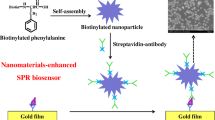Abstract
A rapid and simple surface plasmon resonance (SPR)-based immunoassay for detection of 17β-estradiol was developed. The assay was designed as an inhibitive format, in which 17β-estradiol–BSA conjugates are immobilized on an SPR sensor chip and the binding of antibody to the chip is measured. The binding was inhibited by 17β-estradiol in the concentration range 0.468 to 21.4 nmol L−1 with an IC50 value of 2.29±0.10 nmol L−1. Although not as sensitive as traditional radioimmunoassay (RIA) and enzyme-linked immunoassay (ELISA), this method requires no separation and washing after addition of the antibody, steps which are relatively time-consuming. Estrogen receptor (ER)-binding was then investigated using this SPR immunoassay for the determination of the amount of unbound 17β-estradiol after competition with test compounds for the ER-binding. Inhibition of the binding of 17β-estradiol to ER by diethylstilbestrol (DES) was successfully measured by injecting the reaction mixture into the SPR sensor after addition of the antibody. This binding assay requires no separation of unbound 17β-estradiol from the mixture and no radioisotope- or fluorescence-labeling of 17β-estradiol. These results show the potential usefulness of the SPR sensor both detecting 17β-estradiol and evaluating the ER-binding activity of xenoestrogens such as DES in a single assay system.






Similar content being viewed by others
References
Colborn T, vom Saal FS, Soto AM (1993) Environ Health Perspect 101:378
Desbrow C, Routledge EJ, Brighty GC, Sumpter JP, Waldock M (1998) Environ Sci Technol 32:1549
Snyder SA, Keith TL, Verbrugge DA, Snyder EM, Gross TS, Kannan K, Giesy JP (1999) Environ Sci Technol 33:2814
Huang CH, Sedlak DL (2001) Environ Toxicol Chem 20:133
Diaz-Cruz MS, de Alda MJL, Lopez R, Barcelo D (2003) J Mass Spectrom 38:917
Petrovic M, Eljarrat E, de Alda MJL, Barcelo D (2002) J Chromatogr A 974:23
Isobe T, Shiraishi H, Yasuda M, Shinoda A, Suzuki H, Morita M (2003) J Chromatogr A 984:195
Schwartz JA, Skafar DF (1993) Biochemistry 32:10109
Blair RM, Fang H, Branham WS, Hass BS, Dial SL, Moland CL, Tong WD, Shi LM, Perkins R, Sheehan DM (2000) Toxicol Sci 54:138
Seifert M, Haindl S, Hock B (1999) Anal Chim Acta 386:191
Garrett SD, Lee HA, Morgan MRA (1999) Nat Biotechnol 17:1219
Ohno K, Fukushima T, Santa T, Waizumi N, Tokuyama H, Maeda M, Imai K (2002) Anal Chem 74:4391
Kuramitz H, Natsui J, Sugawara K, Itoh S, Tanaka S (2002) Anal Chem 74:533
Rich RL, Myszka DG (2000) Curr Opin Biotech 11:54
Homola J (2003) Anal Bioanal Chem 377:528
Markgren PO, Hamalainen M, Danielson UH (1998) Anal Biochem 265:340
Myszka DG, Arulanantham PR, Sana T, Wu ZN, Morton TA, Ciardelli TL (1996) Protein Sci 5:2468
Revoltella RP, Robbio LL, Liedberg B (1998) Biotherapy 11:135
Gillis EH, Gosling JP, Sreenan JM, Kane M (2002) J Immunol Methods 267:131
Svitel J, Dzgoev A, Ramanathan K, Danielsson B (2000) Biosens Bioelectron 15:411
Adamczyk M, Gebler JC, Mattingly PG (1996) Bioconj Chem 7:475
Daly SJ, Keating GJ, Dillon PP, Manning BM, O’Kennedy R, Lee HA, Morgan MRA (2000) J Agric Food Chem 48:5097
Stevis PE, Deecher DC, Suhadolnik L, Mallis LM, Frail DE (1999) Endocrinology 140:5455
Koda T, Soya Y, Negishi H, Shiraishi F, Morita M (2002) Environ Toxicol Chem 21:2536
Bolger R, Wiese TE, Ervin K, Nestich S, Checovich W (1998) Environ Health Perspect 106:551
Usami M, Mitsunaga K, Ohno Y (2002) J Steroid Biochem Mol Biol 81:47
Rich RL, Hoth LR, Geoghegan KF, Brown TA, LeMotte PK, Simons SP, Hensley P, Myszka DG (2002) Proc Natl Acad Sci USA 99:8562
Brzozowski AM, Pike AC, Dauter Z, Hubbard RE, Bonn T, Engstrom O, Ohman L, Greene GL, Gustafsson JA, Carlquist M (1997) Nature 389:753
Acknowledgements
We thank Mr Yoshihiro Soya of Toyobo Co., Ltd. for helpful discussions.
Author information
Authors and Affiliations
Corresponding author
Rights and permissions
About this article
Cite this article
Miyashita, M., Shimada, T., Miyagawa, H. et al. Surface plasmon resonance-based immunoassay for 17β-estradiol and its application to the measurement of estrogen receptor-binding activity. Anal Bioanal Chem 381, 667–673 (2005). https://doi.org/10.1007/s00216-004-2952-z
Received:
Revised:
Accepted:
Published:
Issue Date:
DOI: https://doi.org/10.1007/s00216-004-2952-z




